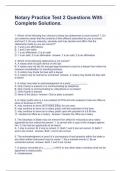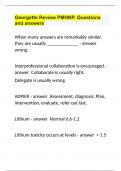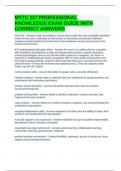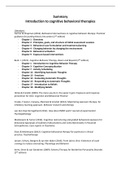A management reporting system in a firm is as the human brain in our body
o A human brain can think and remember (which is a decision-facilitating function), it can
instruct our body parts (which is a decision-influencing function), and it provides
coordination between our body parts (coordination-facilitating function).
Decision-facilitating, decision-influencing and coordination-facilitating function of management
reporting systems
o Decision-facilitating function; it collects information about what happens inside (and
outside) the firm and it provides people in the firm with information. In that way, we
can take decisions in the firm.
o Decision-influencing function; we instruct employees in the firm to act in the best
interest of the firm. It’s about aligning individual behavior with organizational
objectives.
o Coordination-facilitating function; because you collect so much information, you can
motivate people to work together in the firm. You facilitate cooperation between
entities.
Diagnostic and interactive use of management reporting systems
o Diagnostic use of management reporting systems: management reporting systems
facilitate the implementation of the current strategy.
o Interactive use of management reporting systems: management reporting systems
allow to develop a better understanding of the strategic uncertainties that could
instigate a change in the current strategy.
‘The gap’ or the principal-agent problem
o ‘The gap’ is the difference between the effort when you work for yourself and the effort
when you hire someone to do the work for you (and he is paid a fixed salary).
o In a principal-agent problem is the situation in which an individual (the agent or
employee) acts on behalf of another individual (the principal or businessman) and is
supposed to advance the principal’s goal (through providing effort). The problem is that
agents are likely to act in their own self-interest, in order to maximize their own wealth,
but this might not be in the best interest of the principal. The agent’s effort, however,
cannot always be observed by the principal because monitoring is too costly, or the
principal has not enough knowledge to judge the agent’s effort.
Imperfect information in management reporting systems
o A management reporting system provides information about the signals (such as the
number of customer complaints), which are called performance measures, that carry
information about the effort of managers and employees. The information contained in
management reporting system is not perfect because it is costly to collect perfect
information.
Conceptualization of the employee
o In economic models, employees are often assumed to be lazy, selfish and rational. In
reality, however, employees are not always rational.
,EC 2 – The Three-Legged Stool:
The three-legged stool as an analogy for the complementarity between different elements one
has to focus on when implementing a strategy
o Always take all components of the three-legged stool into account when making
changes. They are all linked to each other. You cannot really sit on a three-legged stool
when one leg is too short or too long, or a seating surface that is too small. It’s not a
four-legged stool because the reporting system is directly linked to all three legs.
Different elements of the three-legged stool: organizational design, reporting system,
performance evaluation, and soft controls
o The three legs are organizational design, performance evaluation and soft controls
(which includes culture, leadership, and social norms). On top of that, we have the
reporting system.
EC 3 – Designing Your Organization:
Three-legged stool and its components
o The three legs are organizational design, performance evaluation and soft controls
(which includes culture, leadership, and social norms). On top of that, we have the
reporting system.
Organizational structure (organizing by market, organizing by function, matrix structure)
o Organizing your organization by market can in three ways: by customer, by geography,
or by product. The advantage of organizing by market is a high responsiveness to
changes in customer preferences and market conditions, while the disadvantages are
duplication of functions and costs (for instance, multiple product groups might do the
same form of R&D at Mercedes).
o The advantage of organizing by function is the efficiency in executing the functions, but
a disadvantage might be that you are too slow to recognize new opportunities.
o In a matrix structure you have two dimensions: global categories and regional
categories. Employees report both vertically (to the global level) and horizontally (to the
regional level). The advantage of such a system is that there are many interactions
across dimension. The disadvantages, however, are that the decision-making speed
becomes lower and there is blurred accountability (you have multiple principals to
report to, who need to work together).
Allocation of decision rights
o A decision right determines who decides what and who is accountable for what.
Decision rights can be allocated to different levels of an organization.
Intrinsic value of decision rights
o Suppose you have two lotteries: the control lottery, with an outcome 195 with a chance
of 50% and 75 with a chance of 50%, and a delegation lottery, with an outcome of 190
with a chance of 40% and 100 with a chance of 60%. The certainty equivalent of a
lottery is a guaranteed return that someone would accept now, rather than taking a
chance on a higher, but uncertain, return in the future. A large majority of principals
have a higher certainty equivalent for the delegation lottery than for the control lottery.
, Thus, on average, principals value decision rights intrinsically: CE delegation lottery = CEcontrol lottery
+ intrinsic value of decision rights. We value the fact that we can make decisions.
Control versus delegation
o No delegation (that is, controlling) means that you have to put effort in it, but you can
choose the alternative you want. Delegation means that you save on effort costs, but
the chosen alternative can be another one than the one you prefer the most.
o Delegation occurs when someone with authority refers upon another person the power
to do a particular task.
Centralization versus decentralization
o Control versus delegation is actually the same as centralization versus decentralization.
o When cost-cutting is the major reason to centralize, one should focus on tasks that are
more homogenous across business units (such as IT and HR).
EC 4 – Performance Measures:
Performance measures/KPIs (and all the different types)
o A performance measure (or KPI) is a quantifiable indicator used to assess how well an
organization is achieving its desired objectives.
Sensitivity, precision, congruence, verifiability
o Sensitivity; the extent to which (the expected value of) the performance measure
changes with changes in the agent’s effort.
o Precision; the extent to which (the expected value of) the performance measure is
influenced by factors outside of the control of the manager.
o Verifiability; the extent to which it is ex ante clear how the performance measure is
calculated.
o Congruence; the extent to which the performance measure reflects contribution to
overall firm value.
The relation between delegation and performance measures
o If financial performance measures are good measures (with respect to sensitivity,
precision, and verifiability), delegation and relative incentive use of financial
performance measures (compared to nonfinancial performance measures) are positively
associated. If financial performance measures are bad measures, delegation and relative
incentive use of financial performance measures are negatively associated.
The incentive effect of promotions
o Offering employees the opportunity to get promoted because the probability of a
promotion induces employees to work harder.
The matching effect of promotions
o A firm wants to promote the most capable employees to a higher hierarchical position.
The intertemporal choice problem
o The intertemporal choice problem refers to managers who have a higher preference for
actions from which the benefits are realized at a short(er) term. They do not really care
about the medium term or the period after they left the organization.
Accounting Return Measures









